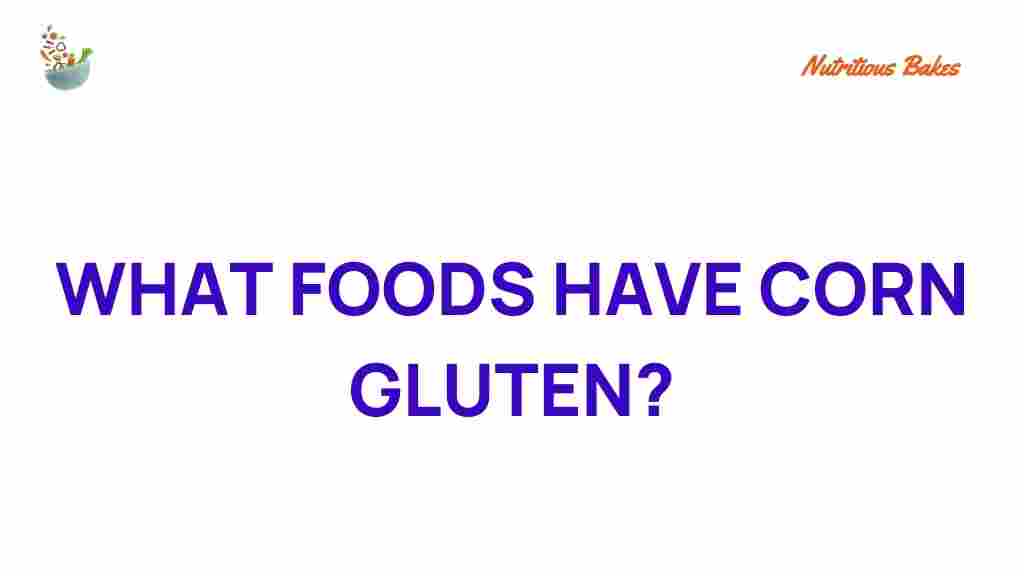Unearthing the Hidden Presence of Corn Gluten in Your Foods
In recent years, consumers have become increasingly vigilant about what goes into their food. With rising dietary restrictions and a growing emphasis on health, understanding food ingredients is essential. One ingredient that often flies under the radar is corn gluten. Despite its name, corn gluten is not harmful gluten; however, its presence in various processed foods can raise questions for those adhering to a gluten-free lifestyle. In this article, we’ll explore corn gluten, its uses in food products, health impacts, and how it fits into food safety protocols.
What is Corn Gluten?
Corn gluten is a byproduct of corn processing and is often used in various food products. It is derived from the endosperm of corn kernels, which is the part of the grain that contains starch and protein. Corn gluten is often confused with gluten found in wheat, barley, and rye, which is a protein that can trigger reactions in those with celiac disease or gluten sensitivity. Understanding its role in food can help consumers make informed choices.
The Role of Corn Gluten in Food Products
Corn gluten serves several purposes in processed foods, including:
- Binding Agent: It helps bind ingredients together, providing texture and stability to food products.
- Thickening Agent: Corn gluten can be used to thicken sauces, soups, and gravies.
- Protein Source: It acts as a plant-based protein source in vegetarian and vegan foods.
- Flavor Enhancer: In some cases, corn gluten can enhance the flavor of processed foods.
Corn Gluten and Dietary Restrictions
For individuals following a gluten-free diet, understanding food ingredients is crucial to avoid any adverse health effects. While corn gluten itself does not contain harmful gluten, it’s essential to be aware of the following:
- Cross-Contamination: Processed foods may be manufactured in facilities that handle gluten-containing grains, leading to potential cross-contamination.
- Ingredient Labels: Always read ingredient labels carefully. Corn gluten may not always be explicitly listed, especially if it’s part of a natural flavoring or a proprietary blend.
- Product Variations: Different brands may use varying formulations; therefore, one product labeled gluten-free may contain corn gluten while another does not.
Health Impacts of Corn Gluten
The health impacts of corn gluten can vary based on individual dietary needs and sensitivities. Here are some considerations:
- Non-Irritating for Most: For the majority of the population, corn gluten does not pose a health risk.
- Potential Allergies: Some individuals may have corn allergies and should avoid corn products altogether.
- Moderation is Key: Like all food ingredients, corn gluten should be consumed in moderation, especially in highly processed foods, which can be lower in nutritional value.
Food Safety and Processed Foods
Food safety is paramount, especially with processed foods that contain multiple ingredients. Here’s how corn gluten fits into the broader conversation about food safety:
- Regulatory Standards: In many countries, food safety regulations require that all ingredients be disclosed, including corn gluten.
- Quality Control: Manufacturers must ensure that their products meet safety standards, including testing for allergens and contaminants.
- Consumer Awareness: As a consumer, staying informed about food safety practices can help you make better choices when selecting processed foods.
Step-by-Step Guide: Identifying Corn Gluten in Your Food
If you’re concerned about corn gluten in your diet, follow these steps to identify its presence:
- Read Labels: Always check the ingredient list on food packaging. Look for terms like “corn gluten meal” or simply “corn gluten.
- Research Brands: Visit brand websites or contact manufacturers to inquire about their use of corn gluten in their products.
- Look for Certifications: Seek out products that are certified gluten-free, which minimizes the risk of cross-contamination.
- Consult Experts: If in doubt, consult a registered dietitian or nutritionist who can provide guidance tailored to your dietary restrictions.
Troubleshooting Tips for Corn Gluten Awareness
Even with diligent efforts, you may encounter challenges when trying to avoid corn gluten. Here are some troubleshooting tips:
- Stay Informed: Keep up with the latest developments in food safety and ingredient labeling.
- Join Support Groups: Engage with communities that focus on gluten-free living to share experiences and tips for navigating food choices.
- Experiment with Alternatives: Explore gluten-free grains like quinoa, rice, or millet as substitutes in your cooking and baking.
- Use Apps: Consider downloading apps that help scan products for allergens and gluten content.
Conclusion
Unearthing the hidden presence of corn gluten in your foods is essential for maintaining a healthy diet, especially for those with dietary restrictions. While corn gluten itself is not harmful, awareness of its uses in processed foods can help you make informed choices. By reading labels, understanding health impacts, and recognizing food safety standards, you can navigate your dietary needs more effectively.
Incorporate these insights into your shopping habits and cooking practices to ensure that your meals align with your health goals. For further reading on gluten-free diets, check out this comprehensive guide. Stay educated, and enjoy the journey of discovering safe and delicious food options!
This article is in the category Ingredients and created by NutritiousBakes Team
